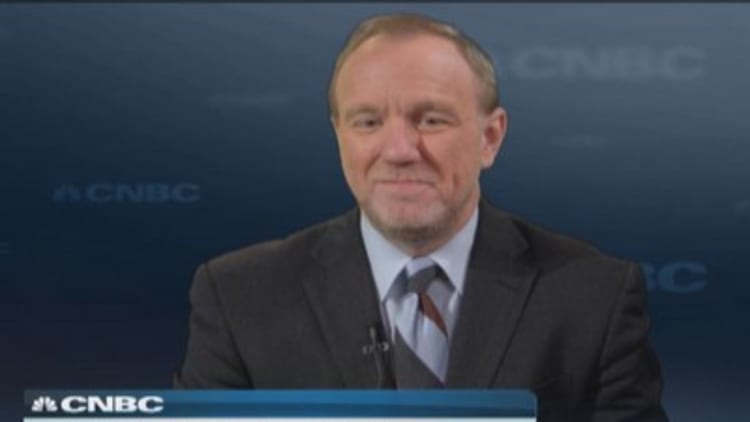
Whipped by volatile internet and biotech stocks, the Nasdaq staged a more than 2 percent rally back from the brink of correction territory Tuesday in the biggest one day turnaround in five years.
At its lowest point Tuesday, the Nasdaq was off 9.7 percent from its March intraday high of 4371 - close to the 10 percent threshold that some traders say marks an official correction. But the market bounced back, and Nasdaq ended the day with an 11 point gain at 4034, about 7.7 percent below its March 6 high.
Some of the very stocks that helped push the to fresh 14-year highs by early March were slammed in early trading Tuesday, adding to losses of more than 20 or 30 percent from their highs. The poster child for momentum—the iShares Nasdaq Biotechnology ETF IBB—was down as much as 24 percent from its Feb. 25 high Tuesday but closed in positive territory.
Social media and internet names were also down sharply, with Facebook and Amazon.com both off more than 20 percent from the March high. But Facebook, Amazon.com and others closed higher on the day.
"This stuff just got tremendously overloved and with anything that's overloved, it turns into obsession," said John Stoltzfus, Oppenheimer Asset Management chief strategist. "Then it turns into a reversal and everyone just gets out of it."
But the reversal may be a head fake and not capitulation. "I think we're still in the process of realizing correct valuation on a group of securities," said Steve Massocca, portfolio manager of the Wedbush Hedged Dividend Fund. "I think there's going to be bounces, and this is one of them."
While both the Nasdaq and small-cap Russell 2000 were down more than 9 percent from their March highs Tuesday, the S&P 500 was down just 4 percent and the Dow down just 3 percent. The Nasdaq's about face was the biggest turnaround since April 1, 2009 when the Nasdaq moved 3.5 percent.
The last time the Nasdaq fell more than 10 percent was from September, 2012 to mid-November, 2012 when it lost 10.9 percent. Earlier that year it lost 12 percent between late March and June 1. Since then, the current decline is the worst for the relatively volatile index, and a 10 percent decline will get attention.
Ten percent from the closing high is 3,922, and 10 percent from its intraday high is 3,934. The Nasdaq hit an intraday high of 4,371 on March 6, but it was still at that point below its March, 2000 record high of 5,132.
Read More29 Nasdaq stocks in bear market territory
"It's not a magic number, but it's a number that people will talk about more. It would be official correction territory," said Paul Hickey, co-founder of Bespoke. "It's all semantics but (10 percent) that's the level you generally consider for a correction. I think it would add more weight to the selloff."
Besides the 10 percent level, the Nasdaq came within four points of its 200-day moving average of 3,942.
"In addition, that 10 percent falls right within 10 points of the 200-day moving average, and we haven't gone through that level in a year," Hickey said. "Technically speaking, a big break of the 200-day moving average is considered a negative." But Hickey said that it is not a consistent metric.
The IBB, watched by traders as a barometer for momentum, broke its 200-day moving average this week and has been trading below it.
Analysts say the Nasdaq correction does not necessarily mean the other indexes will fall as hard. "I don't think just because the Nasdaq is down that much means the others have to fall that much. The Nasdaq tend to be a more volatile index. It's going to have more volatility swings. They don't have the support of the utilities which has been holding up the S&P," Hickey said.
Stoltzfus expects the market to correct mainly around the momentum names. "At the beginning of the year, there was a lot of love for tech. The hedgies got into it, the fast money crowd, and now they're leaving it. A lot of people were looking for a selloff," he said. "The momentum stocks got hit justly for overvaluation. We just see this as really an interlude. It's like a movement in music. It's a downward motion but we don't think it's real meaningful for the course of the year of 2014. If anything, it's probably healthy."
While many Nasdaq names were getting crushed Tuesday, utilities were more than 1 percent higher.
"Dividend yield on the S&P utilities right now is 3.66 percent, which looks a lot better than the 10-year Treasury at 2.61 percent," Stoltzfus said.
He said he does see some value in the older tech names, like Microsoft, and he rated it "market weight." "If you look at the broad (Nasdaq) index, 5 percent (decline) year-to-date, four months into the year, doesn't make us blink much," Stoltzfus said. "We happen not to be chasing momentum stuff. We did with biotech but the Gileads and the Amgens are what we love, and we like the longer-term story on this stuff. We don't think this is the end. This is a detour, but it's not the end of the road."
—By CNBC's Patti Domm


